
 |
Tea Clipper |
 |
| from TeaAntiques.com | ||
| Edition Forty Three |
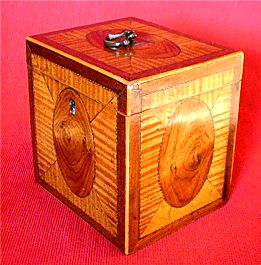
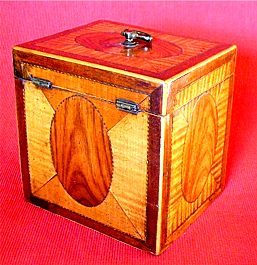
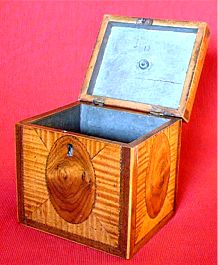
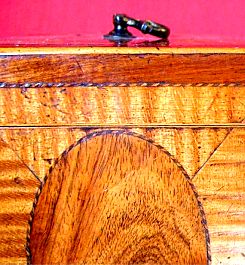 A very attractive George III single cube tea caddy of
the highest
quality, c1785. This stunning tea caddy is unusual in that it has the same very
fine inlaid decoration on all four sides as well as the top. On so many tea
caddies, the decoration is applied only to the top, front and maybe the sides.
With the decoration applied to all sides and the top, it makes this particular
caddy something very special and the quality of the workmanship is extemporary.
A very attractive George III single cube tea caddy of
the highest
quality, c1785. This stunning tea caddy is unusual in that it has the same very
fine inlaid decoration on all four sides as well as the top. On so many tea
caddies, the decoration is applied only to the top, front and maybe the sides.
With the decoration applied to all sides and the top, it makes this particular
caddy something very special and the quality of the workmanship is extemporary.
The decoration includes a central oval medallion in beautifully figured and rich close grained mahogany. This oval medallion is edged with the most tiny and very fine line of 'rope' work inlay, executed in alternating dark and light woods.
This is certainly an exquisite and extremely fine quality George III English Tea caddy, c1785 for the connoisseur collector.
More details of this item and other tea related antiques can be found by visiting my web site at www.TeaAntiques.com.
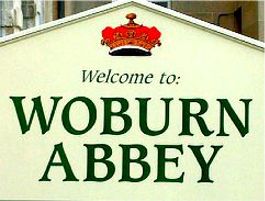 There
is the perfect combination of a beautiful stately home, antique centre and place
in which to enjoy tea to be discovered at Woburn Abbey in Bedfordshire.
There
is the perfect combination of a beautiful stately home, antique centre and place
in which to enjoy tea to be discovered at Woburn Abbey in Bedfordshire.
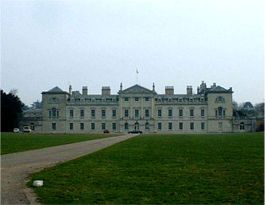 Woburn
Abbey was first opened commercially to the public by the present Duke of
Bedford's grandfather in 1955, so as one of the first houses to open its
doors to the public it has built on experience over the years to become a well
regarded attraction. I had my first visit to this remarkable house this year and
was amazed at the wealth of treasures to be seen and enjoyed within.
Woburn
Abbey was first opened commercially to the public by the present Duke of
Bedford's grandfather in 1955, so as one of the first houses to open its
doors to the public it has built on experience over the years to become a well
regarded attraction. I had my first visit to this remarkable house this year and
was amazed at the wealth of treasures to be seen and enjoyed within.
Woburn is the ancestral home to the Earls and Dukes of Bedford, and today is still their beloved home, currently in the hands of the 15th Duke, Andrew. There is a long line of decedents from the original Russell family going back as far as 1394. It was John Russell, who under the service of King Henry VII was created Baron Russell and Earl of Bedford. He also gained many privileges in the service of Henry VIII and was a Gentleman of the Privy Chamber. He was, for his services, awarded much of the current large Bedford estates.
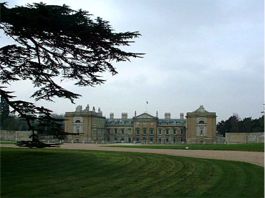 Another
notable Russell was William Russell who was the leader of the Whigs in the
Commons during the Protestant Succession Crisis in the reign of Charles II. He
was able to gain the title Duke of Bedford and then later Marquis of Tavistock
for his father in 1694. Many subsequent Russells have been prominent in their
services to Parliament and the people, including the Fourth Duke of Bedford who
negotiated the Treaty of Paris in 1763.
Another
notable Russell was William Russell who was the leader of the Whigs in the
Commons during the Protestant Succession Crisis in the reign of Charles II. He
was able to gain the title Duke of Bedford and then later Marquis of Tavistock
for his father in 1694. Many subsequent Russells have been prominent in their
services to Parliament and the people, including the Fourth Duke of Bedford who
negotiated the Treaty of Paris in 1763.
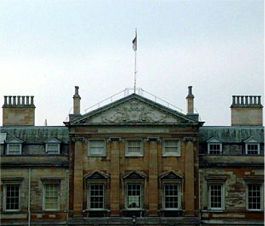 The
history of the house at Woburn dates back to when there was a Cistercian Abbey
built here in 1145, by Huge de Bolebec for a group of monks. The abbey was later
confiscated after Abbot Robert Hobbes was found guilty of treason. Edward VI was
to later grant Woburn Abbey to Sir John Russell in 1547. It was later that the
Fourth Earl actually created Woburn as the main family country seat in 1619. He
built a two storey wing to the north side, in which he created a cool shell
grotto in the centre of the ground floor, an intriguing sight to be seen at
Woburn today.
The
history of the house at Woburn dates back to when there was a Cistercian Abbey
built here in 1145, by Huge de Bolebec for a group of monks. The abbey was later
confiscated after Abbot Robert Hobbes was found guilty of treason. Edward VI was
to later grant Woburn Abbey to Sir John Russell in 1547. It was later that the
Fourth Earl actually created Woburn as the main family country seat in 1619. He
built a two storey wing to the north side, in which he created a cool shell
grotto in the centre of the ground floor, an intriguing sight to be seen at
Woburn today.
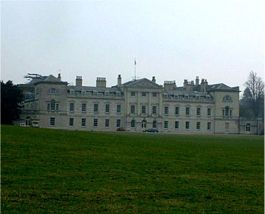 The
West front of the house, which contains a long line of beautiful state rooms on
the first floor, was added in 1747 by the Fourth Duke. It is this magnificent
front that the visitor first sees on approaching the house. This aspect of the
house has a lovely Georgian symmetrical appearance. A central pedimented block
with four giant order pilasters is flanked on either side by five bay wings with
a square block at each end with fine Venetian windows. The Venetian window in
the left pavilion is the magnificent bedroom of Queen Victoria during her stay
at Woburn. From her bedroom progressing along the entire West front on the first
floor are the line of most delightful State Rooms, each having doors that,
when open, allow a view right through from one end of the West front to the
other - an incredible sight.
The
West front of the house, which contains a long line of beautiful state rooms on
the first floor, was added in 1747 by the Fourth Duke. It is this magnificent
front that the visitor first sees on approaching the house. This aspect of the
house has a lovely Georgian symmetrical appearance. A central pedimented block
with four giant order pilasters is flanked on either side by five bay wings with
a square block at each end with fine Venetian windows. The Venetian window in
the left pavilion is the magnificent bedroom of Queen Victoria during her stay
at Woburn. From her bedroom progressing along the entire West front on the first
floor are the line of most delightful State Rooms, each having doors that,
when open, allow a view right through from one end of the West front to the
other - an incredible sight.
The house today has the long impressive West front with a wing going back from either end, the North wing, which houses more state rooms on the first floor and the south wing, which houses many of the family's private rooms. Originally, the house was larger, having an East wing forming the house as a quadrangle around a courtyard, but this wing was later demolished.
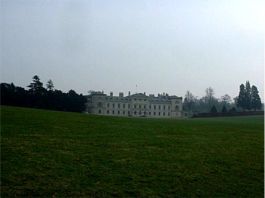 Woburn
is surrounded by a vast park, a landscape improved by Humphry Repton at the
beginning of the nineteenth century.
Woburn
is surrounded by a vast park, a landscape improved by Humphry Repton at the
beginning of the nineteenth century.
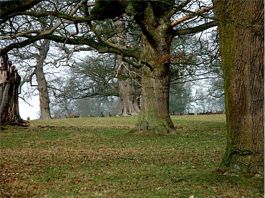 Today, it has some very old oak trees on
this rolling landscape and has large herds of deer roaming freely. The road to
the car park, after passing the West front of the house, takes you a long way
round this park to the North side of the house, so a good chance to enjoy the
nine species of deer and the views.
Today, it has some very old oak trees on
this rolling landscape and has large herds of deer roaming freely. The road to
the car park, after passing the West front of the house, takes you a long way
round this park to the North side of the house, so a good chance to enjoy the
nine species of deer and the views.
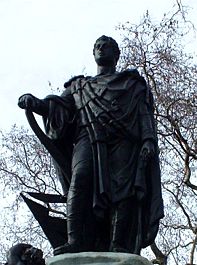
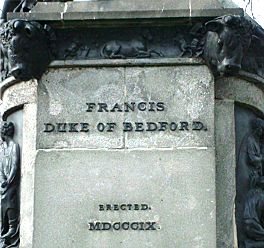
Woburn building was the work of Inigo Jones, who was also responsible for many of the grand and very fine early squares in London. Many of these squares through marriages became the property of the Tavistocks, including Covent Garden, Russell Square and Bloomsbury Square. The Piazza buildings on Covent Garden, which are still there, were built in 1828 by the Sixth Duke of Bedford.
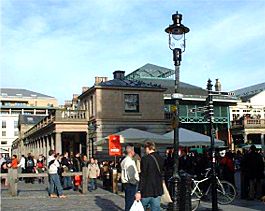
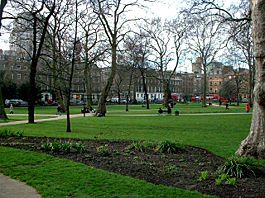
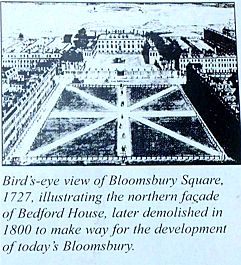
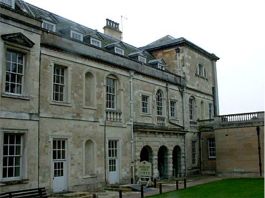 Entrance
to the Abbey is through the North wing. Here on the ground floor are what were
originally some of the family's living quarters until the end of the
Eighteenth century. Today there is the Book Room and Fourth Duke's Bedroom. The
book room contains some marvellous old books, including many fine natural
history books, some of which are displayed open in the book cases that line the
walls, showing some delightful hand coloured illustrations of birds and wildlife,
etc.
Entrance
to the Abbey is through the North wing. Here on the ground floor are what were
originally some of the family's living quarters until the end of the
Eighteenth century. Today there is the Book Room and Fourth Duke's Bedroom. The
book room contains some marvellous old books, including many fine natural
history books, some of which are displayed open in the book cases that line the
walls, showing some delightful hand coloured illustrations of birds and wildlife,
etc.
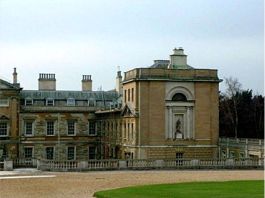 The
Fourth Duke's bedroom has some very fine Mortlake tapestries hung around the
walls, it is nice to see a collection of these early English tapestries dating
from 1661 and 1664. The Bedford family's coat of arms is woven into the top of
each tapestry panel. The subject of these tapestries is the cartoons based on
those by Raphael in 1515 of the acts of the Apostles - these original cartoons by
Raphael are now on permanent loan to the Victoria and Albert museum in London.
The
Fourth Duke's bedroom has some very fine Mortlake tapestries hung around the
walls, it is nice to see a collection of these early English tapestries dating
from 1661 and 1664. The Bedford family's coat of arms is woven into the top of
each tapestry panel. The subject of these tapestries is the cartoons based on
those by Raphael in 1515 of the acts of the Apostles - these original cartoons by
Raphael are now on permanent loan to the Victoria and Albert museum in London.
Passing along a corridor, known as Paternoster Row, the visitor climbs the Grand Staircase, a fine cantilever staircase, to the first floor and its state Rooms. The first of the State Rooms is the Chinese Room, hung with hand painted Chinese wallpaper with exotic birds within a landscape, which follows round a painted river, as it makes its way round the walls of the room. The room contains some furniture reflecting the fashionable taste of Chinese style, including a black lacquered cabinet on stand, English c1755. There are also fine carved seat furniture, again in the Chinese taste such as the carved wood settee, its arms and back of open fret work design.
Progressing along the North wing, the next room is the Flying Duchess's Room. Mary, the Eleventh Duchess, was keen on flying and took flying lessons in 1928. She achieved her private pilot licence and flew her own Gipsy Moth aeroplane. She had a number of incidents during her time flying. After completing 200 hours of solo flying time in 1937, she was to crash on a trip and was sadly killed. She had been a passionate lover of animals and this room reflects this in the animal paintings on the walls, together with photographs of her rather adventurous life on her own boat - 'the Saphire' or on her flying exploits. There is a carpet on the floor of this room with the Bedford coat of arms, this was originally woven for and used on her boat.
The next rooms are the Racing Room and Yellow Drawing Room, very pretty rooms. The Yellow Drawing Room was used by Prince Albert during his stay at Woburn as his sitting room, but prior to this, it was the French Bedroom, it certainly has a great French influence to it. There is a richly gilded ceiling with French looking Rococo plasterwork, including a great gold starburst in the centre. The walls are hung with attractive yellow wallpaper by Zoffany. The room contains some very fine French furniture, some of which were gathered by the Fourth Duke during his time spent in Paris as British Ambassador.
In the Racing Room are many stunning paintings connected with horse racing, a passion of the Dukes of Bedford and displayed are their racing colours.
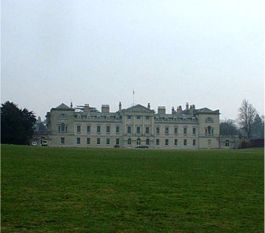 Queen
Victoria's bedroom, which is on the corner of the North wing and the West front,
is a triumph of ornate decoration. It has very striking blue wall coverings, a
most ornate panelled and gilded ceiling and a large four-poster bed hung round
with golden silk. This delightful bedroom is the start of the procession of
State Rooms along the West Front of the house. The room was re-designed by the
Fourth Duke's rebuilding in the eighteenth century. There are paintings of Queen
Victoria on the walls, one of her as a young Princess and one when she was
Queen.
Queen
Victoria's bedroom, which is on the corner of the North wing and the West front,
is a triumph of ornate decoration. It has very striking blue wall coverings, a
most ornate panelled and gilded ceiling and a large four-poster bed hung round
with golden silk. This delightful bedroom is the start of the procession of
State Rooms along the West Front of the house. The room was re-designed by the
Fourth Duke's rebuilding in the eighteenth century. There are paintings of Queen
Victoria on the walls, one of her as a young Princess and one when she was
Queen.
Continuing along the West Front is the Dressing Room of Queen Victoria, with the same bright blue wall covering, very ornate gilded ceiling, lovely landscape paintings and fine French furniture. It is a cosy looking room, made so by comfortable padded arm chairs.
The next room is the Blue Drawing Room, yet again the same wall covering, which unites these rooms. This is I think one of my favourite rooms in the house. It is large and has a grand look about it whilst still remaining a comfortable looking room. Once again, there is a beautiful ceiling with intricate plasterwork of gilded panels and in the centre hangs a French glass chandelier. The furniture includes a stunning suite of gilt framed saloon furniture covered in blue silk to match the wall coverings. This beautiful suite of furniture has settees, open arm chairs and side chairs. One of my affinities with this charming room is its historic connection with the creation of afternoon tea, served with food. It was in this very room, that the Duchess Anna Maria in the early nineteenth century was credited with the invention of this as a meal. She found the time between luncheon and dinner too long and unbearable with out food, so had light food served to her with her mid-afternoon tea, and so the afternoon tea was born. I love this Duchess already, obviously a woman after my own heart! The food she may have enjoyed with tea maybe samples of food to be served at dinner and maybe some cakes. Today, the room reflects this important invention of afternoon tea, with a table indeed set out for tea. The table is set with fine porcelain tea wares, not very old, but delicate and dainty. There is a tea kettle at hand to replenish the teapot with hot water during tea and a hand bell on the table for summoning the footman.
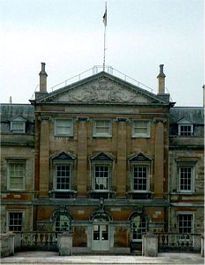 Next
in the line of rooms is the largest and grandest room, the state Saloon, located
in the centre of the West Front. As this room is so large, it occupies the first
and second floor to accommodate the coffered ceiling and lend the correct
proportions to the room. The walls of this room are of great fascination as when
the room was redecorated in 1973 they were pained with murals illustrating some
of the characters of the Russell family and places that have a connection with
the family. Thus there are views of parts of London which are easily
recognisable such as Covent Garden and St Paul's cathedral. What an imposing
saloon for grand gatherings.
Next
in the line of rooms is the largest and grandest room, the state Saloon, located
in the centre of the West Front. As this room is so large, it occupies the first
and second floor to accommodate the coffered ceiling and lend the correct
proportions to the room. The walls of this room are of great fascination as when
the room was redecorated in 1973 they were pained with murals illustrating some
of the characters of the Russell family and places that have a connection with
the family. Thus there are views of parts of London which are easily
recognisable such as Covent Garden and St Paul's cathedral. What an imposing
saloon for grand gatherings.
The next three rooms are associated with eating, the State Dining Room; The Breakfast Room and the Canaletto Room - now the family's own dining room.
The State dining room has a large rectangular mahogany dining table on which
is displayed a family service of Meissen porcelain. Each of the pieces is
decorated with birds in landscapes and dates from c1800, like on this similar
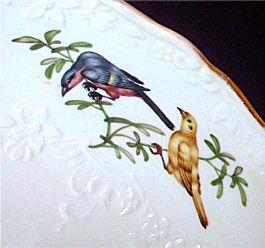 Meissen
plate. Also on the table two
fine and sparkling glass candelabra and English eighteenth century cordial wine
glasses with air twist stems c1760. Surrounding the table is a quality set of
splat back dining chairs of Virginian walnut, c1740. These with their pierced
back splat have a top rail with scrolls at each end and stand on wonderful
carved cabriole legs terminating in ball and claw feet.
Meissen
plate. Also on the table two
fine and sparkling glass candelabra and English eighteenth century cordial wine
glasses with air twist stems c1760. Surrounding the table is a quality set of
splat back dining chairs of Virginian walnut, c1740. These with their pierced
back splat have a top rail with scrolls at each end and stand on wonderful
carved cabriole legs terminating in ball and claw feet.
The Breakfast Room is more informal and intimate and a delightful room in which the family can enjoy their breakfast at a smaller circular table. The room is now set for breakfast so it is easy to imagine this room in use by the family.
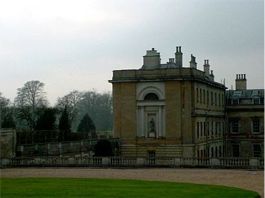 The
family's own dining room, which is used today, is a room on the South- West corner
of the house, so a very light room. The walls are hung with many exquisite
Canaletto paintings showing detailed scenes, just like modern day photographs of
holidays. These paintings set against rich red walls are so striking. This room
and some of the other rooms on the South wing are not always open to the public,
as they are very much in use by the current Duke of Bedford and his family, so I
was lucky during my visit to the house.
The
family's own dining room, which is used today, is a room on the South- West corner
of the house, so a very light room. The walls are hung with many exquisite
Canaletto paintings showing detailed scenes, just like modern day photographs of
holidays. These paintings set against rich red walls are so striking. This room
and some of the other rooms on the South wing are not always open to the public,
as they are very much in use by the current Duke of Bedford and his family, so I
was lucky during my visit to the house.
In the basement of the house, not to be missed, are extensive displays and cabinets containing a wealth of family silver, porcelain and gold items. These displays are quite mind blowing for the lover of such high quality antiques and it would be easy to spend a lot of time here admiring these treasures.
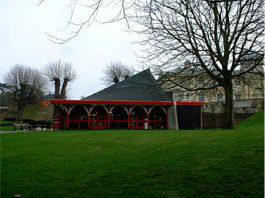
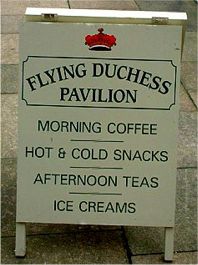
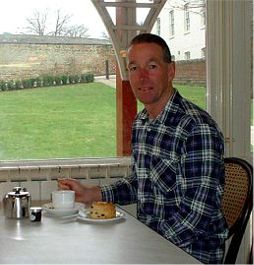
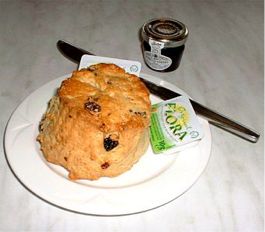 Leaving the house, it was time for a much needed afternoon tea. There is a
modern tearoom sited just to the East of the North side of the house. I thought
that if afternoon tea was invented by the Duchess of Bedford, that there must be
a good afternoon tea served at Woburn. I had a pot of tea with a fruit scone and
jam. It was very pleasant and the scone nice and fresh, however, I could not
help thinking that this side of Woburn could do with a bit of improvement, with
maybe a better style room, more traditional, without the modern cafe type of
furniture and perhaps to offer more formal and elegantly served teas with finger
sandwiches and fancy cakes. Despite this, I did enjoy my tea and scone, much
needed after enjoying so many treasures within such a fine house.
Leaving the house, it was time for a much needed afternoon tea. There is a
modern tearoom sited just to the East of the North side of the house. I thought
that if afternoon tea was invented by the Duchess of Bedford, that there must be
a good afternoon tea served at Woburn. I had a pot of tea with a fruit scone and
jam. It was very pleasant and the scone nice and fresh, however, I could not
help thinking that this side of Woburn could do with a bit of improvement, with
maybe a better style room, more traditional, without the modern cafe type of
furniture and perhaps to offer more formal and elegantly served teas with finger
sandwiches and fancy cakes. Despite this, I did enjoy my tea and scone, much
needed after enjoying so many treasures within such a fine house.
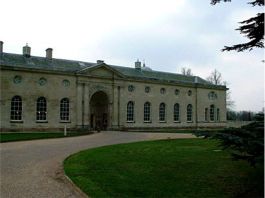
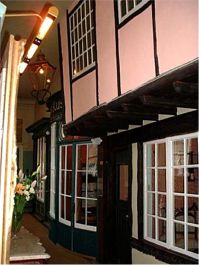
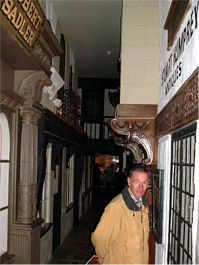
The third treat at Woburn for the lover of quality antiques is a well run antique centre housed in the old stable block. This block, now houses small eighteenth century shop fronts that have been rescued, to form individual dealers' shops. There are some very fine shop fronts to admire and some interesting antiques that can be bought. It is nice to be able to admire the treasures in Woburn Abbey and also to be able to take home some fine antiques of your own. I found a very pretty George III single cube tea caddy which had beautiful inlay on all four sides and lid, which I was told by the antique centre manager, that the current Duke of Bedford had looked at that very morning and had liked it - what better pedigree, so I had to buy it and is now my Featured Antique.
I hope that you have enjoyed reading about Woburn Abbey and I hope that one day you may too get the opportunity to share in its delights in person.
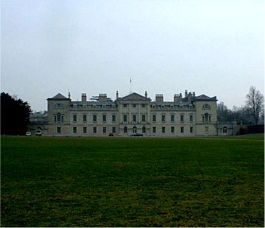
Click here for
Map
Map courtesy of www.streetmap.co.uk
To review past newsletters, just follow this link:
Past newsletters.
To subscribe to this free newsletter -
Click here